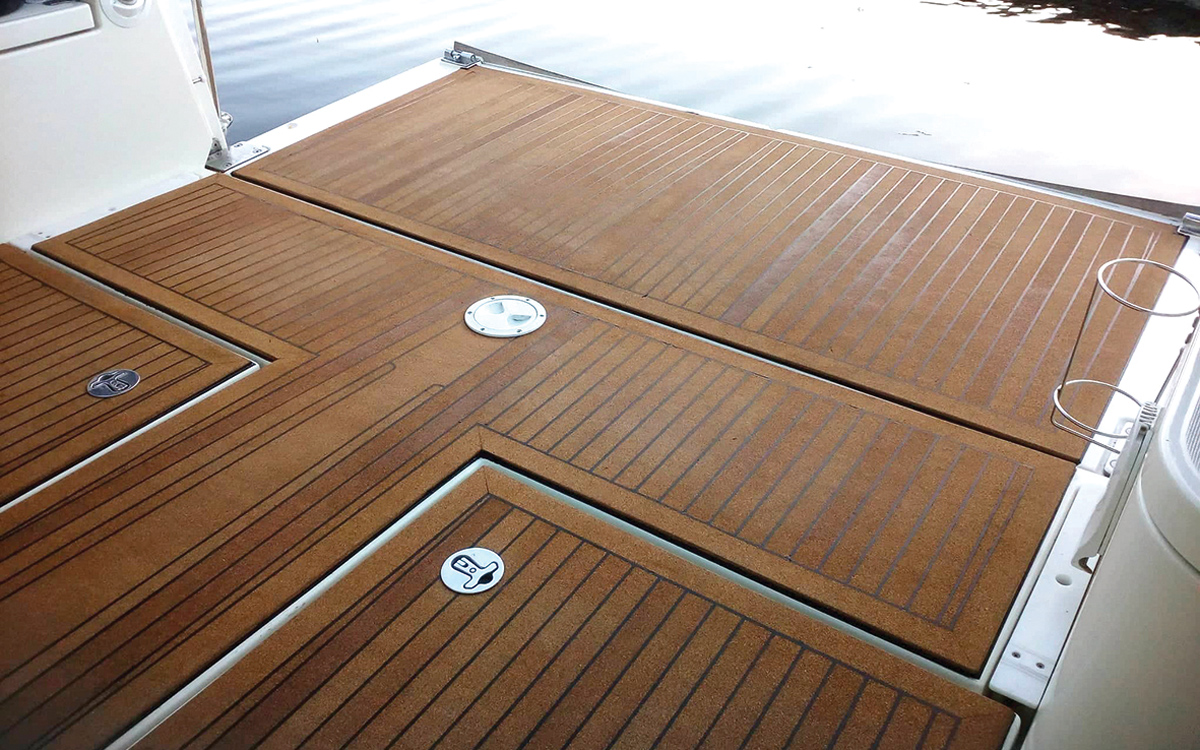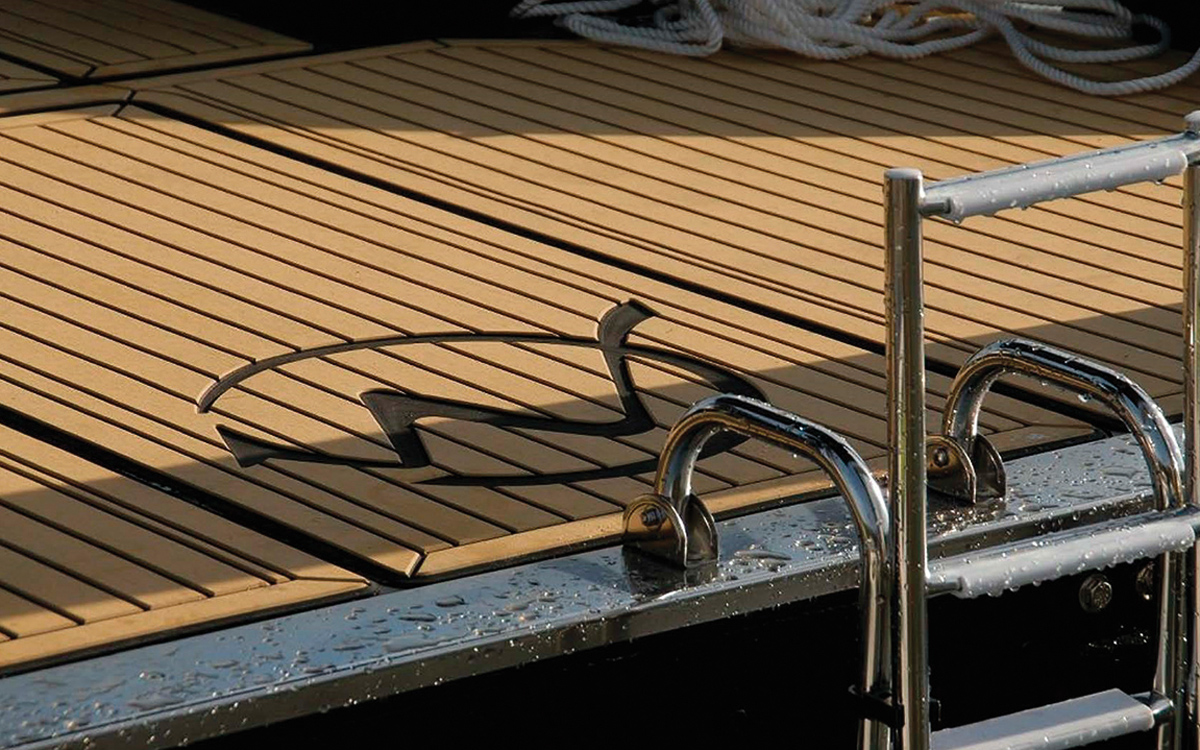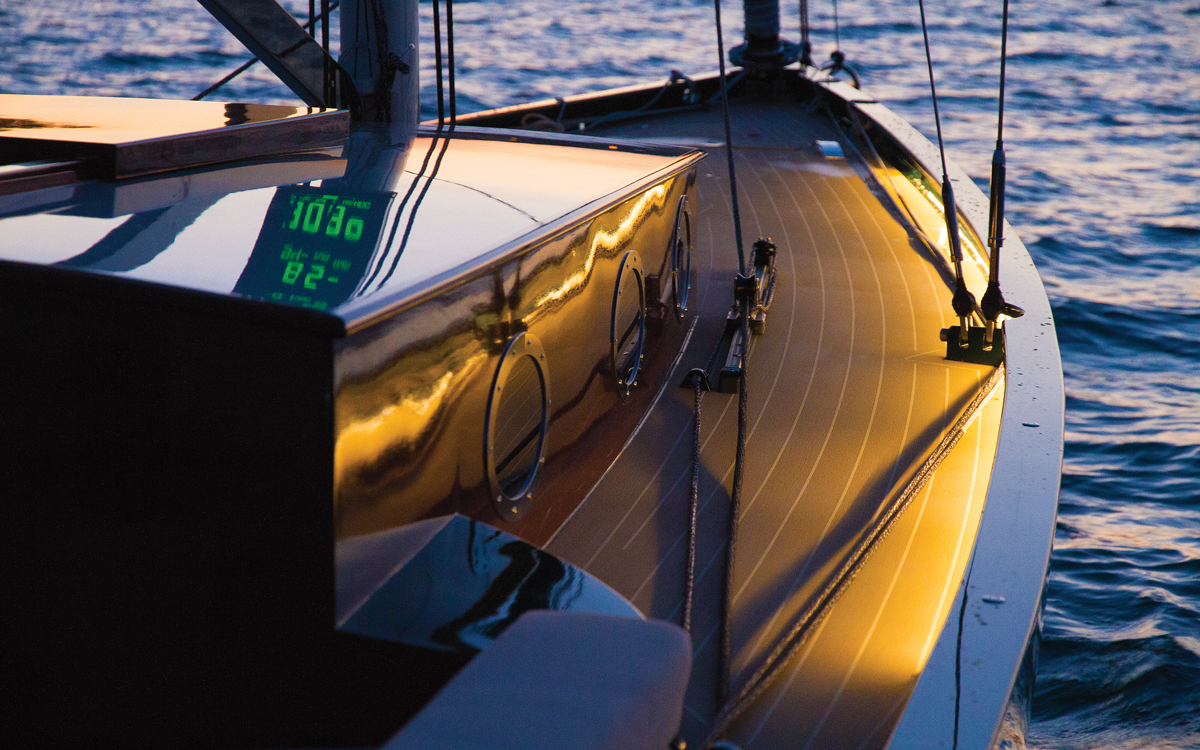Rupert Holmes explains what’s wrong with the marine industry’s obsession with hardwood and looks at real world teak alternatives
Everyone loves an immaculate teak deck. They look great at boat shows and at chic Mediterranean quays, as well as providing excellent non-slip properties in the most demanding of conditions.
However, teak also has drawbacks. Firstly it doesn’t last forever, especially if a modern, and likely relatively thin, teak deck is scrubbed regularly. At the extreme I’ve seen a deck lose 1mm of thickness each year through scrubbing. Given the high cost of replacement this can have a significant impact on a yacht’s resale value.
The material also easily absorbs heat from the sun, making it uncomfortable to walk on in bare feet when in the tropics or Mediterranean summer. This also contributes to heating the interior of the boat.

Ocean Cork is one of many firms to offer eco-friendly teak alternatives
Teak doesn’t look good from a sustainability perspective either. A key problem is illegal logging of rainforest in Myanmar, one of the only four countries in which the species grows. Unfortunately, a ban on importing this illegal timber into the EU hasn’t stopped the trade, as evidenced by court cases in countries including Denmark, Sweden, Germany and Holland following the discovery of illegally imported teak.
As a result, the only way to be absolutely certain a source of teak is sustainable is to use salvaged material (or to ensure that the teak can be GPS-traced back to stump).
Timber at risk
“Teak is now considered a high risk timber,” confirms Nigel Stuart, MD of Spirit Yachts. “We take our responsibility to the environment very seriously and we are not prepared to risk using unsustainable wood.”
Teak alternatives have been available for many years and are gaining wide acceptance. In many cases they also offer multiple advantages over real teak, including better longevity. Many can be factory-made to match a template or CAD file, which significantly reduces labour and installation costs, while customisation can extend to logos and boat names.
Available products can be split into four broad categories:
- PVC
- Cork
- Modified softwoods
- Expanded foam
Many of these don’t absorb liquids and are therefore easy to keep clean as any dirt stays on the surface.
Article continues below…
4 eco-friendly improvements to upgrade your yacht
1. Ditch the teak Teak is no longer universally popular. The price has gone up dramatically, supply is dwindling, and…
How hybrid sailing yachts finally became a feasible option
Every sailor is familiar with the wet cough of the diesel engine, and the acrid smell of its exhaust. For…
Many manufacturers offer a range of colours, with the most popular being shades close to freshly-scrubbed teak, or silvered, weathered teak. The former can look amazing at boat shows, though in the real world it can maybe look incongruous to those who understand the damage regular scrubbing does to real teak.
We’ve tried to give indicative prices for different options, but these are exceptionally difficult to pin down. Different products may need vastly different amounts of labour, which obviously affects cost, while detailing and edging is a major factor in the price of factory-made panels. The total cost for boats of similar sizes can therefore vary dramatically depending on the complexity of each of the panel shapes.
1. PVC decks
This option has historically offered some of the most convincing alternative teak products, with the grain, texture, impact resistance and non-slip properties of the real thing. As a result many of the new yachts seen at boat shows actually have simulated teak decks made of PVC.

Flexiteek decking on the SW105 Kiboko III
Despite their slightly textured surface, which replicates the grain of real wood, dirt and stains stay on the surface of PVC decking, so it can be cleaned relatively easily with a wet cloth and maybe soapy water. Unlike real teak, which has a mix of hard and very soft fibres, PVC decks can also be pressure-washed. Another bonus is that damaged areas can be sanded back to reveal fresh material that looks new.
One of the best-known brand names, Flexiteek, is celebrating its 20th anniversary and is expanding rapidly, with demand consistently growing at 20% annually. The company now produces 80,000m2 of its decking product each year.
The 2G version, launched six years ago, is fully recyclable, while microballoons are used in place of chalk filler, which reduces heat absorption (certain PVC deck types and colours have been known to get very hot in direct sun). Flexiteek is available in a standard 5mm thickness and 11 colours, with plank widths from 45mm-200mm to replicate everything from planking to covering boards and cappings.
Flexiteek says PVC experts suggest the surface may start to crack after 25-30 years, but no problems have been observed on 20-year-old decks so far and the life span may be considerably longer. High traffic areas can become glossy, but these can be gently coarse sanded back by hand to the original matt finish.

Esthec seamless decking installed on a Princess R35
Esthec is a part of composite floor specialist Bolidt, which makes flooring in any shape for industrial applications through to decking for ships. Dutch yard Saffier has been fitting Esthec to its range of daysailers since 2008.
“We made one deck with Esthec and set this right next to a real teak deck,” managing director Dennis Hennevanger remembers, having been immediately taken by the product. “We invited all the customers who had ordered a Saffier with teak deck and gave them the choice… they instantly all went for the Esthec deck.”
Saffier has since built nearly 500 yachts with Esthec decks, “all without any problems”. Hennevanger says it is not necessarily a cheaper option to teak, but thinks it should last forever.

Saffier’s SE37 daysailer is fitted with PVC decks from Esthec
“I also like the technical side of Esthec,” he adds. “It is made completely seamless [the caulking doesn’t go right through], so it is impossible to have any leakages.” Additional benefits are that it is maintenance free, with no fading, has excellent anti-slip properties and comes with a complete freedom of design.
PlasDeck is less well known in the UK but has been established for 15 years, offering a range of PVC products in 28 shades that look and feel like wood. The company holds patents for non-migratory plasticisers that are bound to the molecular structure. The product is therefore very UV resistant and remains elastic as the oils don’t evaporate over time.
Fungus inhibitors throughout the material hold back the formation of the green mould that can all too easily grows on real teak decks, especially during persistently damp winters.

Permateek decking on a Contest 38
Permateek is another popular brand name and has recently introduced new shades that better mimic the grain of real teak. From a sustainability perspective, a big drawback with PVCs is they are plastics and will therefore remain in the environment forever. To offset this Flexiteek plants one tree for every 10m2 of product sold. Esthec, meanwhile is formed from natural components, without the harmful ingredients commonly found in PVCs.
Prices for PVC products tend to range from €150 to €1,000 per square metre, varying according to the design and size of each panel. As a guide, in the UK Permateek costs £150-£350/m2 depending on the complexity of the design. This compares to a material cost of around £285/m2 for 6mm teak – but don’t forget there’s far more labour involved in laying a real teak deck.
Gisatex offers a more economic PVC product, at €69 per square metre, but in a thinner textured, non-slip material that makes no attempt to match the grain of teak. The company, which has been established for 10 years, sells matched repair kits for €10 and says a “very long lifespan is expected.” Light weight is a further advantage, but custom panels are not available.

Gisatex sits at the lower end of the PVC price bracket
Cork
There’s an increasing trend towards cork decking, according to Piet van der Staay of Marinedeck 2000, especially among younger boat owners. It’s a natural product harvested from FSC certified forests, largely in Portugal.
Common advice is to look for a product with large cork grains as these cope better with impact. In any case the material is inherently resilient and is significantly better than teak at resisting wear and abrasion.
Cork is also is a good insulator, so decks remain comfortable to walk on even in strong sun. Over a three to five year period it will slowly take a light grey hue, but this can be sanded back to reveal the original colour.

Marinedeck claims that its decking is popular among younger boaters
Marinedeck 2000 consists of cork granules with a synthetic polyurethane binder. It’s produced under high pressure, which gives the feel of high-density material, but is still flexible and absorbs knocks well. It’s supplied as individual planks, or as preformed finished pieces with a standard thickness of 9mm. The company has been in operation since 1986 and says there are still decks in good condition from its early days. As a result van der Staay quotes a 40-year expected lifespan.
Prices for Marinedeck 2000 start at €320/m2 (ex VAT) including adhesives, while custom panels cost €520/m2 (ex. VAT).
Another supplier, Ocean Cork, produces 8mm planks as standard, but 4mm is available if weight is critical. Given it’s one of the lightest decking materials available, at only 2.4kg/m2, for cruisers the thinner option appears to offer little benefit. Prices start at €349 (inc. VAT) for 1m2 DIY kit (including glue and caulking) and approx €400/m2 (inc. VAT) for larger custom made panels.

Ocean Cork is available in 8mm and 4mm thickness
Expanded foam
This is a material with a soft cushioned feel, excellent grip underfoot and good shock-absorbing properties. SeaDek, which is made from a closed-cell PE/EVA foam is popular throughout the racing world, from sportsboats to the America’s Cup and the Ocean Race. It can be made in custom panels and in different thicknesses and is manufactured with an effective acrylic-based pressure sensitive adhesive for quick peel-and-stick application.
SeaDek’s Jason Gardner says the large range of colour, thickness, density and design options means the price range can be very wide. Whether or not there’s already a pattern for that model of boat in the company’s database also impacts pricing.
Sean Roebuck of ProCast, SeaDek’s leading UK fabricator, says prices including VAT generally work out in the range of £114-£151/m2.

SeaDek is popular with ocean racers. Photo: Ainhoa Sanchez/VOR
Cer-Deck, sold by Italian company Ceredi, also has a soft, slightly cushioned feel, very high resistance to degradation in sunlight and is colour stable.
It is 6-8mm thick and is available with a strong 3M self-adhesive backing to minimise labour costs when fitting. Custom panels cost around €250/m2 (ex. VAT).
Life expectancy for expanded foam materials is around five to seven years for harsh use, and longer for less-heavily used boats. On the downside these materials are susceptible to damage from impact or pets’ claws.

Cer-Deck has a soft, cushioned feel
Modified softwood
Lignia is the latest product to be launched on the market, based on pine grown in FSC certified forests. After harvesting, the timber is impregnated with resin, before being dried in a curing process to ensure the resin is locked in at a molecular level. This gives Lignia performance and durability that can surpass tropical hardwoods.
It has a similar appearance to teak and can be worked in the same way, but has an expected lifespan of 50 years. The impregnation of resin means end of life disposal is not as easy as for untreated timber – the recommended option is to use it as fuel in biomass generating plants.
Anyone who saw the Spirit 50CR at last year’s Southampton Boat Show can attest that a quality yacht with Lignia decks will look stunning. It also has the benefit in being faster to dry than teak, which is handy in areas used for seating. Material costs are a little less than for teak, with typical savings around 5-20%. However, Lignia decks are just as labour intensive to lay as real teak.

Lignia, shown to great effect here on the decks of the Spirit 50CR, is a real softwood product treated to give it the appearance and longevity of teak
Price gauge
Tye Conway of UK-based decking specialist Elite-Teak says that typical installed prices in the UK are often lower than elsewhere in northern Europe, with many jobs falling into the following price ranges (ex. VAT) per square metre:
Synthetic teak: £200-£300
Foam decking: £150-£200
Cork decking: £200-£300
Real teak decking: £500-£600
Teak-effect solar panels
Italian solar panel manufacturer Solbian has a range of panels with a pigmented layer that creates different colour schemes. The teak option reduces output by only 6-8% compared to an equivalent standard panel, while custom sizes and shapes can be created without increasing prices.

The upcoming Spirit 44E will be fitted with teak-effect solar panels
The company has been working on projects with major boat manufacturers – the panels will be used, for instance, on the locker hatches of the aft deck of the Spirit 44E that’s currently in build. Solbian is also developing a version of the teak-effect panel with a non-slip finish.
Colour shades can also be matched to products of companies such as Flexiteek. Prices are typically 50% to 60% above those for the company’s standard solar panels.
First published in the April 2020 edition of Yachting World.






